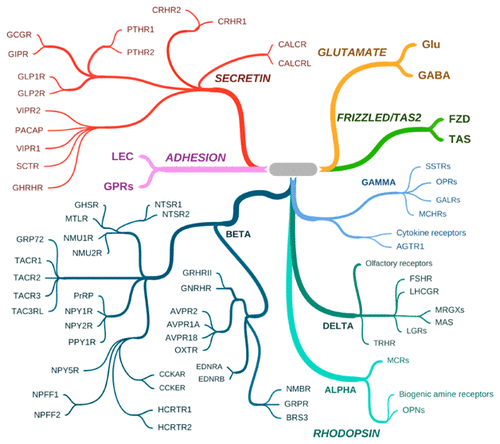当前位置:
X-MOL 学术
›
ACS Pharmacol. Transl. Sci.
›
论文详情
Our official English website, www.x-mol.net, welcomes your
feedback! (Note: you will need to create a separate account there.)
Peptide-Liganded G Protein-Coupled Receptors as Neurotherapeutics.
ACS Pharmacology & Translational Science ( IF 4.9 ) Pub Date : 2020-03-18 , DOI: 10.1021/acsptsci.0c00017 Lee E Eiden 1 , Ki Ann Goosens 2 , Kenneth A Jacobson 3 , Lorenzo Leggio 4 , Limei Zhang 5
ACS Pharmacology & Translational Science ( IF 4.9 ) Pub Date : 2020-03-18 , DOI: 10.1021/acsptsci.0c00017 Lee E Eiden 1 , Ki Ann Goosens 2 , Kenneth A Jacobson 3 , Lorenzo Leggio 4 , Limei Zhang 5
Affiliation

|
Peptide-liganded G protein-coupled receptors (GPCRs) are a growing fraction of GPCR drug targets, concentrated in two of the five major GPCR structural classes. The basic physiology and pharmacology of some within the rhodopsin class, for example, the enkephalin (μ opioid receptor, MOR) and angiotensin (ATR) receptors, and most in class B, all the members of which are peptide receptors, are well-known, whereas others are less so. Furthermore, with the notable exception of opioid peptide receptors, the ability to translate from peptide to "drug-like" (i.e., low-molecular-weight nonpeptide) molecules, with desirable oral absorption, brain penetrance, and serum stability, has met with limited success. Yet, peripheral peptide administration in patients with metabolic disorders is clinically effective, suggesting that "drug-like" molecules for peptide receptor targets may not always be required for disease intervention. Here, we consider recent developments in GPCR structure analysis, intracellular signaling, and genetic analysis of peptide and peptide receptor knockout phenotypes in animal models. These lines of research converge on a better understanding of how peptides facilitate adaptive behaviors in mammals. They suggest pathways to translate this burgeoning information into identified drug targets for neurological and psychiatric illnesses such as obesity, addiction, anxiety disorders, and neurodegenerative diseases. Advances centered on the peptide ligands oxytocin, vasopressin, GLP-1, ghrelin, PACAP, NPY, and their GPCRs are considered here. These represent the spectrum of progress across the "virtual pipeline", of peptide receptors associated with many established drugs, those of long-standing interest for which clinical application is still under development, and those just coming into focus through basic research.
中文翻译:

肽连接的G蛋白偶联受体作为神经治疗药物。
肽连接的G蛋白偶联受体(GPCR)是GPCR药物靶标的增长部分,主要集中在五个主要GPCR结构类别中的两个中。视紫红质类中的一些基本生理学和药理学是众所周知的,例如脑啡肽(μ阿片受体,MOR)和血管紧张素(ATR)受体,并且大多数在B类中,所有成员均为肽受体。 ,而其他情况则并非如此。此外,除了阿片类肽受体的显着例外,具有令人满意的口服吸收,脑渗透和血清稳定性的从肽翻译成“药物样”(即低分子量非肽)分子的能力已得到满足。成功有限。然而,代谢紊乱患者外周肽的给药在临床上是有效的,这表明“药物样” 用于肽受体靶标的分子可能并不总是需要进行疾病干预。在这里,我们考虑了动物模型中GPCR结构分析,细胞内信号传导以及肽和肽受体敲除表型的遗传分析的最新进展。这些研究方向集中在对肽如何促进哺乳动物适应性行为的更好理解上。他们提出了将这种迅速发展的信息转化为已确定的针对神经系统疾病和精神疾病的药物靶标的途径,例如肥胖,成瘾,焦虑症和神经退行性疾病。本文考虑了以肽配体催产素,加压素,GLP-1,生长素释放肽,PACAP,NPY及其GPCRs为中心的进展。这些代表了整个“虚拟管道”的进展范围,
更新日期:2020-04-23
中文翻译:

肽连接的G蛋白偶联受体作为神经治疗药物。
肽连接的G蛋白偶联受体(GPCR)是GPCR药物靶标的增长部分,主要集中在五个主要GPCR结构类别中的两个中。视紫红质类中的一些基本生理学和药理学是众所周知的,例如脑啡肽(μ阿片受体,MOR)和血管紧张素(ATR)受体,并且大多数在B类中,所有成员均为肽受体。 ,而其他情况则并非如此。此外,除了阿片类肽受体的显着例外,具有令人满意的口服吸收,脑渗透和血清稳定性的从肽翻译成“药物样”(即低分子量非肽)分子的能力已得到满足。成功有限。然而,代谢紊乱患者外周肽的给药在临床上是有效的,这表明“药物样” 用于肽受体靶标的分子可能并不总是需要进行疾病干预。在这里,我们考虑了动物模型中GPCR结构分析,细胞内信号传导以及肽和肽受体敲除表型的遗传分析的最新进展。这些研究方向集中在对肽如何促进哺乳动物适应性行为的更好理解上。他们提出了将这种迅速发展的信息转化为已确定的针对神经系统疾病和精神疾病的药物靶标的途径,例如肥胖,成瘾,焦虑症和神经退行性疾病。本文考虑了以肽配体催产素,加压素,GLP-1,生长素释放肽,PACAP,NPY及其GPCRs为中心的进展。这些代表了整个“虚拟管道”的进展范围,











































 京公网安备 11010802027423号
京公网安备 11010802027423号